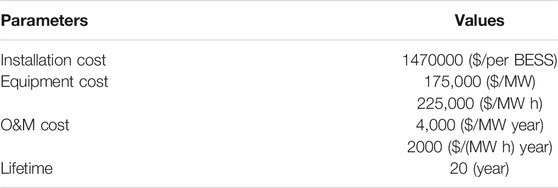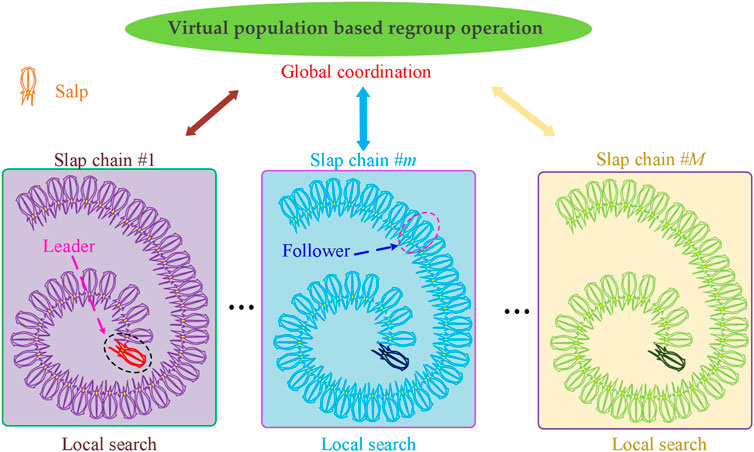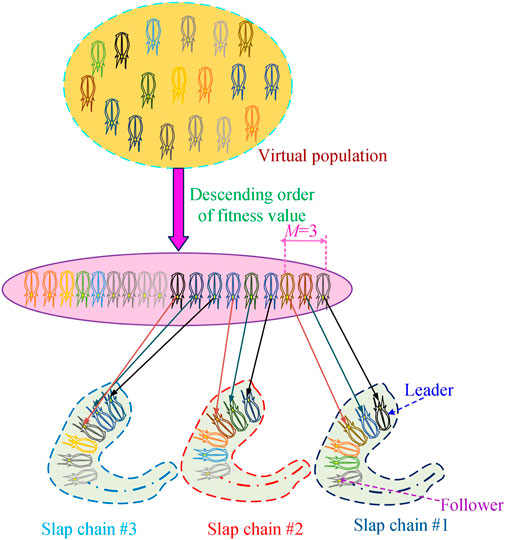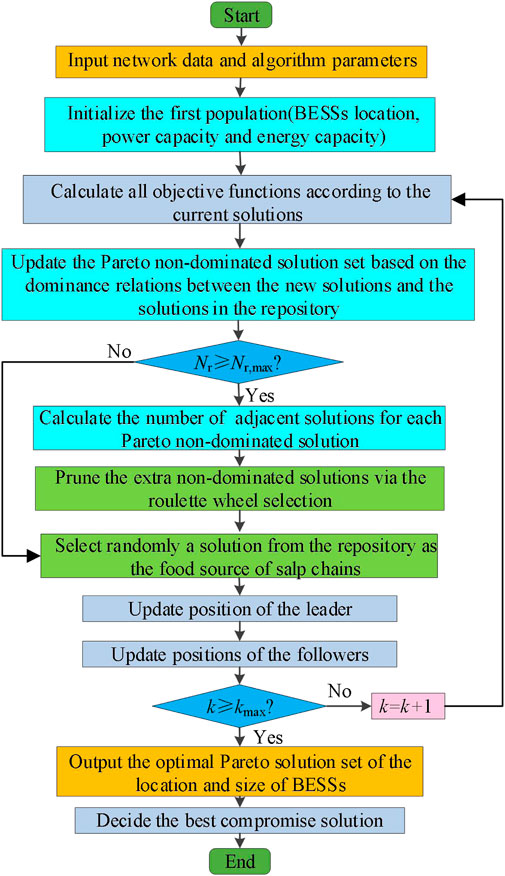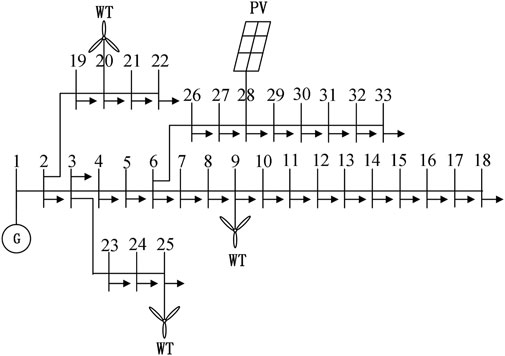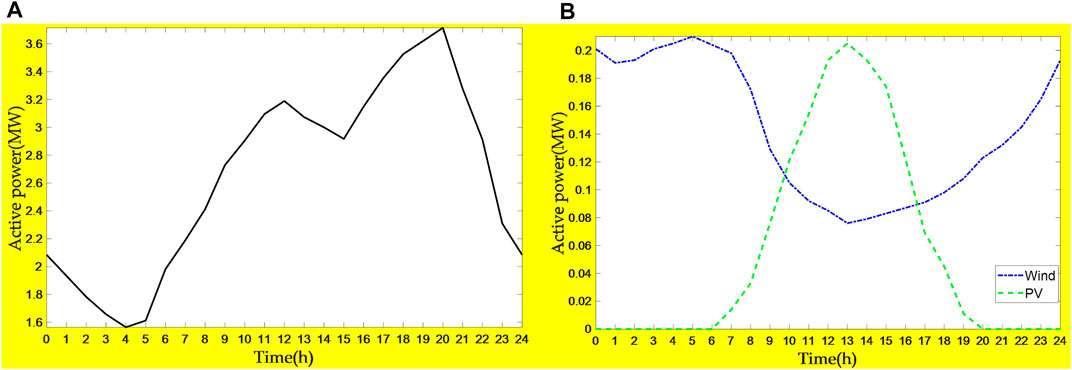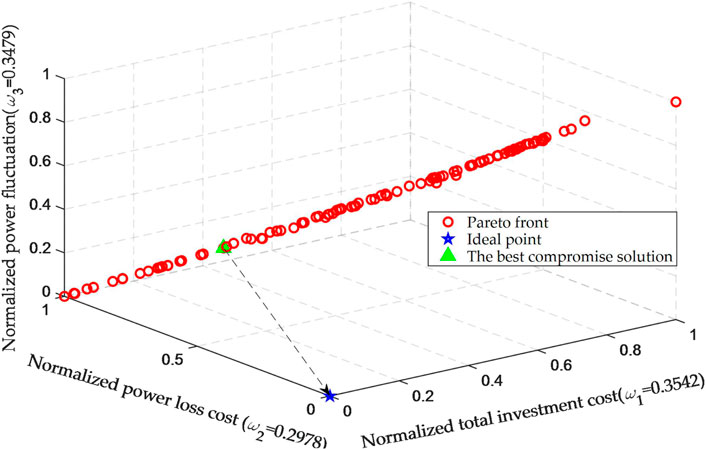- 1Grid Planning and Research Center, Guangdong Power Grid Corporation, China Southern Power Grid Company Limited, Guangzhou, China
- 2Guangdong Power Grid Corporation, China Southern Power Grid Company Limited, Guangzhou, China
- 3State Key Laboratory of Advanced Electromagnetic Engineering and Technology, School of Electrical and Electronic Engineering, Huazhong University of Science and Technology, Wuhan, China
Battery energy storage systems (BESSs) are a key technology to accommodate the uncertainties of RESs and load demand. However, BESSs at an improper location and size may result in no-reasonable investment costs and even unsafe system operation. To realize the economic and reliable operation of BESSs in the distribution network (DN), this paper establishes a multi-objective optimization model for the optimal locating and sizing of BESSs, which aims at minimizing the total investment cost of BESSs, the power loss cost of DN and the power fluctuation of the grid connection point. Firstly, a multi-objective memetic salp swarm algorithm (MMSSA) was designed to derive a set of uniformly distributed non-dominated Pareto solutions of the BESSs allocation scheme, and accumulate them in a retention called a repository. Next, the best compromised Pareto solution was objectively selected from the repository via the ideal-point decision method (IPDM), where the best trade-off among different objectives was achieved. Finally, the effectiveness of the proposed algorithm was verified based on the extended IEEE 33-bus test system. Simulation results demonstrate that the proposed method not only effectively improves the economy of BESSs investment but also significantly reduces power loss and power fluctuation.
Introduction
In recent years, distributed generators (DGs) and controllable load in the distribution network (DN) have continued to increase, meaning that the traditional DN faces many challenges (Sepulveda Rangel et al., 2018; Liu et al., 2020; Peng et al., 2020). At present, one obvious tendency is that the rapid-developed photovoltaic (PV) and wind turbine (WT) power generation technologies make the permeability of distributed PV and WT in the DN higher. A series of problems ensue, such as voltage quality declination and power supply reliability reduction, etc (Wang et al., 2014; Yu et al., 2016; Sun et al., 2020). The active power through the line increases at the peak of power load, the loss increases, and a large voltage offset appears at the end of the line (Kerdphol et al., 2016a; Zhou et al., 2021).
Battery energy storage systems (BESSs) have the characteristics of flexibility and fast response and are an effective way to solve the above problems. The application of BESSs can greatly improve the connection of renewable energy sources (RESs) (Kerdphol et al., 2016b; Gan et al., 2019; Hlal et al., 2019). BESSs can effectively solve the problems of enlarging the load peak and off-peak difference, delay in the power grid upgrading, alleviate the power supply capacity shortage in the transition phase of the power grid, improve the reliability and stability of the power grid, and optimize the power flow of the grid, as well as improving the economic benefits of system operation (Chong et al., 2016; Chong et al., 2018; Murty and Kumar., 2020). BESSs could provide a new direction for large-scale RESs integration, which is one of the most effective ways to solve renewable energy grid access (Trovão and Antunes, 2015; Liu et al., 2018; Wu et al., 2019).
However, prudent BESSs allocation and sizing in DN determine the satisfactory performance of BESSs applications. The optimal allocation and sizing of BESSs are crucial for the power quality improvement of DN and transmission system protection settings. Once BESSs are connected to the DN, the dispatching system of DN sends dispatching instructions to the BESSs according to the real-time running state of the system load, and then BESSs absorbs or sends power to the parallel network through its two-way energy flow (He et al., 2017; Jia et al., 2017; He et al., 2020). This two-way power regulation can save investment and improve the reliability and economy of BESSs. If the location and sizing of BESSs are not set reasonably, or the operation strategy adopted fails to efficiently play the role of BESSs, the voltage quality may deteriorate, and further increase investment and operation costs (Li et al., 2020). To enable us to take full advantage of distributed BESSs and make their access to the DN have a positive impact, it is important to select the appropriate location and sizing of BESSs based on the appropriate operation strategy (Li et al., 2018).
Recently, a large number of scholars have performed studies in this field (Yang et al., 2020). The literature (Oudalov et al., 2007) tends to optimize the location and power capacity of BESSs by calculating the sensitivity of network loss, and then reduce the power loss of DN. In one study (Pang et al., 2019), a semi-definite relaxation method was proposed to solve the optimal BESSs allocation problem. Another study (Wong et al., 2019) introduces a whale optimization algorithm for the optimal location and sizing of BESSs, while the optimization results do not achieve a significant breakthrough.
This paper devises a multi-objective optimization model considering total investment cost, power loss cost, and power fluctuation for optimal BESSs locating and sizing. For the sake of solving this model, a multi-objective memetic salp swarm algorithm (MMSSA) is proposed to search the non-dominated solutions of BESSs allocation strategy, which reach significant improvement and better balance on the global exploration and local exploitation abilities compared with the salp swarm algorithm (SSA). Furthermore, the ideal-point decision method (IPDM) is adapted to objectively determine the optimal weight coefficients of each objective function and then select the best compromised solution. To verify the effectiveness, the proposed model and algorithm are implemented in the extended IEEE-33 bus test system.
The rest of this paper is organized as follows: Problem Formulation develops the multi-objective optimization model. In Multi-Objective Memetic Salp Swarm Algorithm Based on Pareto, MMSSA based on IPDM is introduced. Case studies are undertaken in Case Studies. Finally, Conclusion summarizes the main contributions of this study.
Problem Formulation
Objective Functions
The optimal allocation of BESSs is a multi-objective optimization problem with multiple variables and constraints. To realize the economic and reliable operation of BESSs in the DN, a multi-objective optimization model is established based on the Pareto principle, where minimizing the total investment cost of BESSs, power loss cost, and power fluctuation are the main objectives.
Total Investment Cost
This paper focuses on the DN that has been built and operated, so the investment and construction costs of DN other than BESSs are not included in the cost model. The economic parameters of BESSs are provided in Table 1, extracted from a previous study (Behnam and Sanna, 2015). The total investment cost is considered as the annual costs of BESSs, which can be mathematically formulated as follows
where
The annual installation cost of BESSs is expressed as
where
where
where
The annual equipment cost of BESSs is calculated by
where
The annual O&M cost of BESSs is expressed as
where
Power Loss Cost
BESSs grid-connected will change the power flow of DN (Injeti and Thunuguntla, 2020). Furthermore, the different locations and sizes of BESSs will have different influences on power losses. For the sake of minimizing the total active power losses, the power losses index is established in the optimization model, as follows
where
Power Fluctuation
Owing to the intermittent nature of RESs, the integration of them into power grids poses significant power fluctuation in the grid connection point. However, BESSs can provide an effective supplement for RESs in smoothing power fluctuation to improve power quality. The power quality index can be expressed as
where
Constraints
Power Balance
where
Range of Node Voltages
where
Charging and Discharging Power Limits of BESSs
where
State of Charge Limits
where
Multi-Objective Optimization Model
Establishment of the Optimization Model
In terms of multi-objective optimization problems such as BESSs allocation, all objectives generally conflict with each other, and optimizing one of the objectives leads to the deterioration of other objectives in most cases. It is difficult to objectively evaluate the superiority-inferiority of all solutions because there is no absolute optimal solution for the overall objective (Huang et al., 2020). Nevertheless, there exists an optimal solution set, elements of which are named Pareto optimal solutions, realizing the optimum matching among objectives (Fonseca and Fleming, 1993). In this paper, the multi-objective optimization model of BESSs locating and sizing is designed to simultaneously meet investment economy and operation reliability requirements, as follows
where
Design of Optimization Variables
Optimization variables include the installation locations, power, and energy capacities of two BESSs, all of which need to be constructed in a reasonable range, otherwise, some negative effects on the power flow, relay protection, voltage, and waveform of the original power grid raise. In this paper, nodes in the range of (Mirjalili et al., 2017; Liu et al., 2020) were selected as the installation locations, in which environmental and geographical factors need to be considered in engineering practice. The limits of power and energy capacities are determined to consider the topology of DN, the power limit of the interconnection point, especially the total load power. Therefore, the power capacity allowed to access the power grid of a BESS is determined as 90% of the total active power load of the power grid, and the numerical value of energy capacity limit is equal to power capacity limit, as follows
where
Note that the power and energy capacities of two BESSs are continuous, while installation locations are discrete. In this paper, continuous variables can converge to the optimal value in the iteration process while the optimal value of discrete variables needs to be rounded in continuous space (Zhang et al., 2017).
Multi-Objective Memetic Salp Swarm Algorithm Based on Pareto
Memetic Salp Swarm Algorithm
Optimization Framework
SSA is inspired by the swarming motility and foraging behavior of salps, which successfully solves varieties of optimization problems since it has a simple search mechanism and high optimization efficiency (Mirjalili et al., 2017). In recent years, the memetic algorithm has developed into a broad class of algorithms and can properly combine global search and local search mechanisms (Moscato, 1989; Neri and Cotta, 2012). In this paper, the memetic computing framework first proposed by Moscato (Moscato, 1989) is adopted in the memetic salp swarm algorithm (MSSA) to improve the searching ability of SSA. Then, multiple slap chains were employed to better balance global exploration and local exploitation abilities. Therefore, there are two important search mechanisms in MSSA, namely the local search in a single chain and the global coordination in the whole population. In MSSA, multiple salp chains are arranged in parallel, where each salp chain is regarded as a swarm of salps that independently perform local searches similar to SSA. Meanwhile, all salp chains are regrouped by information communication among all salps for the improvement of convergence stability. The optimization framework of MSSA is illustrated in Figure 1.
Mathematical Model
In the single chain, the salps can be divided into two roles, including the leaders and the followers. As illustrated in Figure 1, the leader is regarded as the salp at the front of each salp chain, while the rest of the salps are followers. In each iteration, the leading salp seeks the food source, while the follower salps follow each other in a row. Note that the best salp with the best fitness is considered to be the food source, and will be chased by the whole salp chain. The position of the leading salp and follower salps can be updated as follows (Mirjalili et al., 2017)
where the j means the jth dimension of searching space;
where k and kmax are the current iteration number and maximum iteration number, respectively.
In the salp population, each salp is taken as an individual of the virtual salp population. At each iteration, the population can be regrouped into multiple new salp chains based on the descending order of all salps’ fitness values. In the regroup operation, the global coordination among different salp swarms is achieved, as shown in Figure 2. It can be seen that the best solution is assigned to salp chain #1, and then the second-best solution is assigned to salp chain #2, and so on. Therefore, the mth salp chain can be updated by (Eusuff and Lansey, 2015)
where
Multi-Objective Memetic Salp Swarm Algorithm
As discussed in Problem Formulation, the solutions for a multi-objective problem should be a set of Pareto optimal solutions. MSSA can drive salps towards the food source with the best solution for the optimization problem and update it at each iteration. The design of MMSSA is first to equip the food sources with a repository to restore the non-dominated solutions obtained by MSSA so far (Coello et al., 2004). In the optimization process, every new non-dominated solution needs to be compared against all residents in the repository using the Pareto dominance operators, as follows (Faramarzi et al., 2020).
• If a new solution dominates a set of solutions in the repository, they have to be swapped;
• If at least one of the solutions in the repository dominates the new solution, this new solution should be discarded straight away;
• If a new solution is non-dominated in comparison with all repository residents, this new solution will be added to the repository.
The repository can just store limited solutions. Therefore, a wise method adopted to remove the similar non-dominated solutions in the repository, is that the one in the populated region is identified as the best candidate to be removed from the repository to improve the distribution diversity of the Pareto optimal solution set. The solutions that are removed from the repository need to satisfy the following equation
where
In this paper, the IPDM was adopted to filter out the best compromised solution of the Pareto non-dominated solution set, which is often used in multiple attribute decision making. Firstly, the objective functions of all Pareto non-dominated solutions obtained by MPOA are normalized as follows
where
Thus, an ideal point can be selected in the target decision-making region formed by all Pareto non-dominated solutions. It is worth mentioning that the objective functions of the ideal point can be normalized to be (0, 0, 0) in terms of the minimization problem. Crucially, the squared Euclidean distance between different solutions and the ideal point is taken as an important basis for ranking all non-dominated solutions and then decide the best compromised solution from them. The squared Euclidean distance can be calculated by
Owing to the weights of each objective function obtained by IPDM, it does not rely on the evaluation and preference of experts so that the decision is credible. In the end, the best compromised solution is expressed as
To sum up, the flowchart of MMSSA to solve the optimal locating and sizing of BESSs is shown in Figure 3.
Case Studies
Test System
In this section, the optimal locating and sizing of BESSs based on MMSSA is implemented in the extended IEEE-33 bus system for verifying the effectiveness of the proposed algorithm. The topology structure of the test system with a total load of 3,715 + j2300 kVA is depicted in Figure 4. It is assumed that the resource units include one PV and three WT, where the maximum generation limits of PV and WT both are 0.2 MW. The typical daily curves of load, wind and PV power are demonstrated in Figure 5. In addition, multi-objective particle swarm optimization (MOPSO) (Hlal et al., 2019) is used for comparison. For the sake of a relatively fair comparison, the population size of MMSSA and other algorithms all are set to 100, and the maximum iterations are set to be 500. The size of the repository was chosen to equal 100 for multi-objective optimization. Some specific parameters of all comparison algorithms were set to the default values. If the parameters are not chosen properly, the convergence time will be too long or the local optimum will be trapped. It is worth mentioning that the key parameters in the MMSSA algorithm, such as c1, the most important parameter since they can directly influence the trade-off between exploration and exploitation. To achieve a proper balance, it was designed according to the iteration number.
Simulation Results
Figure 6 and Figure 7, respectively, exhibit the bi-objective Pareto front curves by two algorithms, including the total investment cost versus the power loss cost, the total investment cost versus the power fluctuation, as well as the power loss cost versus power fluctuation, which demonstrates these three bi-objective Pareto fronts obtained by MMSSA are more uniform than MOPSO from the perspective of distribution. Figure 8 shows the three-objective Pareto front obtained by two algorithms. As can be seen from Figure 8, MMSSA can acquire the Pareto solution set with higher quality compared with MOPSO. Moreover, the schematic diagram of the IPDM based on MMSSA is illustrated in Figure 9. Figure 9 shows the normalized objective function curve based on MMSSA, as well as the decision-making schematic for the best compromise solution of BESSs allocation. IPDM based on MMSSA can obtain the objective weight coefficients and select the best compromise solution by means of the sum of squares of Euclidean distance.
To better compare the convergence and diversity of the Pareto solution set obtained by two algorithms, the performance indexes are evaluated in Table 2, including coverage over the Pareto front (CPF) (Tian et al., 2019), spread (Wang et al., 2010), spacing (Schott, 1995), and execution time. It is worth mentioning that CPF defines the diversity of Pareto solution set as its coverage over the Pareto front in an (M-1) dimensional hypercube (Wang et al., 2010), while spread and spacing respectively denote the diversity and the evenness of the Pareto solution set, which are all the negative indexes. In addition, Table 3 shows the best compromise decision scheme of BESSs allocation from two algorithms, along with the objective function values. It is evident that the MMSSA outperforms the MOPSO in the multi-objective optimization model for optimal locating and sizing of BESSs:
• It has the smallest CPF value, indicating that MMSSA owns better diversity;
• It gains the smallest spread and spacing value, which indicates that the Pareto solutions obtained by MMSSA are evenly and widely distributed on the Pareto front;
• It also has the smallest execution time, which means that MMSSA can converge to the Pareto front much faster than conventional MOPSO;
• It has the least investment cost, meaning that MMSSA can improve the economy of BESSs investment;
• It slightly reduces power loss cost, and ensures a higher operation economy of DN;
• It significantly gains lower power fluctuation of the grid connection point, which means MMSSA can contribute to power supply reliability.
Conclusion
In this paper, a multi-objective optimization model based on the Pareto principle was established. This study proposes MMSSA as a method for solving the optimal location and size of BESSs in DN. The contributions of the proposed approach are as follows:
• The multi-objective optimization model takes the economic criteria, incorporates time value into cost, and the technical criteria relate to system reliability and take it into consideration, which aims to make BESSs more cost-effective and ensure the reliable operation of DN;
• The proposed MMSSA has a strong global search ability and convergence ability under complex multi-objective functions, which can quickly search high-quality non-dominated solutions, and then objectively select the best compromised solution with the help of IPDM;
• The simulation results based on the extended IEEE-33 bus test system effectively verify that the best-compromised solution of BESSs allocation scheme obtained by MMSSA owns the lowest investment cost, power loss cost, and power fluctuation, which is beneficial for DN to increase economic efficiency and improve system reliability.
However, there are several limitations to this work, including the inapplicability of the proposed MMSSA for the high-dimension optimization problem, and the limited scenario design in terms of validating its effectiveness. Therefore, the MMSSA can be further enhanced to improve the accuracy for high-dimensional objective optimization. Meanwhile, a multi-scenario design that combines different typical daily data in a year should be conducted to capture the time-variable nature and uncertainties related to RESs and load demand.
Data Availability Statement
The original contributions presented in the study are included in the article/supplementary material, further inquiries can be directed to the corresponding author.
Author Contributions
SP and XG contributed to conception and design of the study. XiL and XuL performed the case analysis. SP wrote the first draft of the manuscript. XG, XiL, XuL, and XA wrote sections of the article. All authors contributed to article revision, read, and approved the submitted version.
Funding
The paper is funded by the project supported by the China Southern Power Grid Science and Technology Project under Project 037700KK52190011 (GDKJXM20198273).
Conflict of Interest
Authors SP, XG, XiL, and XuL were employed by the company China Southern Power Grid Company Limited.
The remaining author declares that the research was conducted in the absence of any commercial or financial relationships that could be construed as a potential conflict of interest.
Publisher’s Note
All claims expressed in this article are solely those of the authors and do not necessarily represent those of their affiliated organizations, or those of the publisher, the editors and the reviewers. Any product that may be evaluated in this article, or claim that may be made by its manufacturer, is not guaranteed or endorsed by the publisher.
Acknowledgments
The authors gratefully acknowledge that this project was supported by the China Southern Power Grid Science and Technology Project under Project 037700KK52190011 (GDKJXM20198273).
References
Behnam, Z., and Sanna, S. (2015). Electrical Energy Storage Systems: A Comparative Life Cycle Cost Analysis. Renew. Sust. Energ. Rev. 42, 569–596. doi:10.1016/j.rser.2014.10.011
Chong, L. W., Wong, Y. W., Rajkumar, R. K., and Isa, D. (2018). An Adaptive Learning Control Strategy for Standalone PV System with Battery-Supercapacitor Hybrid Energy Storage System. J. Power Sourc. 394, 35–49. doi:10.1016/j.jpowsour.2018.05.041
Chong, L. W., Wong, Y. W., Rajkumar, R. K., and Isa, D. (2016). An Optimal Control Strategy for Standalone PV System with Battery-Supercapacitor Hybrid Energy Storage System. J. Power Sourc. 331, 553–565. doi:10.1016/j.jpowsour.2016.09.061
Coello, C. A. C., Pulido, G. T., and Lechuga, M. S. (2004). Handling Multiple Objectives with Particle Swarm Optimization. Evol. Comput. IEEE Trans. 8, 256–279. doi:10.1109/tevc.2004.826067
Eusuff, M. M., and Lansey, K. E. (2015). Optimization of Water Distribution Network Design Using the Shuffled Frog Leaping Algorithm. J. Water Resour. Plann. Manag. 129 (3), 210–225. doi:10.1061/40569(2001)412
Faramarzi, A., Heidarinejad, M., and Stephens, b. (2020). Equilibrium Optimizer: a Novel Optimization Algorithm. Knowledge Based Syst. 191, 105190. doi:10.1016/j.knosys.2019.105190
Fonseca, C. M., and Fleming, P. J. (1993). Genetic Algorithms for Multiobjective Optimization: Formulation Discussion and Generalization. Icga 93, 416–423.
Gan, W., Ai, X., Fang, J., Yan, M., Yao, W., Zuo, W., et al. (2019). Security Constrained Co-planning of Transmission Expansion and Energy Storage. Appl. Energ. 239, 383–394. doi:10.1016/j.apenergy.2019.01.192
Harvey, H. L. D. (2020). Clarifications of and Improvements to the Equations Used to Calculate the Levelized Cost of Electricity (LCOE), and Comments on the Weighted Average Cost of Capital (WACC). Energy 207, 118340. doi:10.1016/j.energy.2020.118340
He, X., Ai, Q., Qiu, R. C., Huang, W. T., Piao, L. J., and Liu, H. C. (2017). A Big Data Architecture Design for Smart Grids Based on Random Matrix Theory. IEEE Trans. Smart Grid. 8 (2), 674–686.
He, X., Qiu, R. C., Ai, Q., and Zhu, T. Y. (2020). A Hybrid Framework for Topology Identification of Distribution Grid with Renewables Integration. IEEE Trans. Power Syst. 36 (2), 1493–1503. doi:10.1109/tpwrs.2020.3024955
Hlal, M. I., Ramachandaramurthya, V. K., Padmanaban, S., Kaboli, H. R., Pouryekta, A., and Tuan Abdullah, T. A. R. b. (2019). NSGA-II and MOPSO Based Optimization for Sizing of Hybrid PV/wind/battery Energy Storage System. Ijpeds 10 (1), 463–478. doi:10.11591/ijpeds.v10.i1.pp463-478
Huang, Z., Fang, B. L., and Deng, J. (2020). Multi-objective Optimization Strategy for Distribution Network Considering V2G Enabled Electric Vehicles in Building Integrated Energy System. Prot. Control. Mod. Power Syst. 5 (1), 48–55. doi:10.1186/s41601-020-0154-0
Injeti, S. K., and Thunuguntla, V. K. (2020). Optimal Integration of DGs into Radial Distribution Network in the Presence of Plug-In Electric Vehicles to Minimize Daily Active Power Losses and to Improve the Voltage Profile of the System Using Bioinspired Optimization Algorithms. Prot. Control. Mod. Power Syst. 5 (1), 21–35. doi:10.1186/s41601-019-0149-x
Jia, K., Chen, Y., Bi, T., Lin, Y., Thomas, D., and Sumner, M. (2017). Historical-data-based Energy Management in a Microgrid with a Hybrid Energy Storage System. IEEE Trans. Ind. Inf. 13 (5), 2597–2605. doi:10.1109/tii.2017.2700463
Kerdphol, T., Fuji, K., Mitani, Y., Watanabe, M., and Qudaih, Y. (2016). Optimization of a Battery Energy Storage System Using Particle Swarm Optimization for Stand-Alone Microgrids. Int. J. Electr. Power Energ. Syst. 81, 32–39. doi:10.1016/j.ijepes.2016.02.006
Kerdphol, T., Qudaih, Y., and Mitani, Y. (2016). Optimum Battery Energy Storage System Using PSO Considering Dynamic Demand Response for Microgrids. Int. J. Electr. Power Energ. Syst. 83, 58–66. doi:10.1016/j.ijepes.2016.03.064
Li, R., Wang, W., Chen, Z., and Wu, X. (2018). Optimal Planning of Energy Storage System in Active Distribution System Based on Fuzzy Multi-Objective Bi-level Optimization. J. Mod. Power Syst. Clean. Energ. 6 (2), 342–355. doi:10.1007/s40565-017-0332-x
Li, Y., Vilathgamuwa, M., Choi, S. S., Xiong, B., Tang, J., Su, Y., et al. (2020). Design of Minimum Cost Degradation-Conscious Lithium-Ion Battery Energy Storage System to Achieve Renewable Power Dispatchability. Appl. Energ. 260, 114282. doi:10.1016/j.apenergy.2019.114282
Liu, J., Yao, W., Wen, J., Fang, J., Jiang, L., He, H., et al. (2020). Impact of Power Grid Strength and PLL Parameters on Stability of Grid-Connected DFIG Wind Farm. IEEE Trans. Sustain. Energ. 11 (1), 545–557. doi:10.1109/tste.2019.2897596
Liu, Z., Chen, Y., Zhuo, R., and Jia, H. (2018). Energy Storage Capacity Optimization for Autonomy Microgrid Considering CHP and EV Scheduling. Appl. Energ. 210, 1113–1125. doi:10.1016/j.apenergy.2017.07.002
Mirjalili, S., Gandomi, A. H., Mirjalili, S. Z., Saremi, S., Faris, H., and Mirjalili, S. M. (2017). Salp Swarm Algorithm: A Bio-Inspired Optimizer for Engineering Design Problems. Adv. Eng. Softw. 114, 163–191. doi:10.1016/j.advengsoft.2017.07.002
Moscato, P. (1989). On Evolution, Search, Optimization, Genetic Algorithms and Martial Arts: Towards Memetic Algorithms. Caltech Concurrent Computation Program, Technical Reports 826.
Murty, V. V. S. N., and Kumar, A. (2020). Multi-objective Energy Management in Microgrids with Hybrid Energy Sources and Battery Energy Storage Systems. Prot. Control. Mod. Power Syst. 5 (1), 1–20. doi:10.1186/s41601-019-0147-z
Neri, F., and Cotta, C. (2012). Memetic Algorithms and Memetic Computing Optimization: A Literature Review. Swarm Evol. Comput. 2, 1–14. doi:10.1016/j.swevo.2011.11.003
Oudalov, A., Chartouni, D., and Ohler, C. (2007). Optimizing a Battery Energy Storage System for Primary Frequency Control. IEEE Trans. Power Syst. 22 (3), 1259–1266. doi:10.1109/tpwrs.2007.901459
Pang, M., Shi, Y., Wang, W., and Pang, S. (2019). Optimal Sizing and Control of Hybrid Energy Storage System for Wind Power Using Hybrid Parallel PSO-GA Algorithm. Energy. explorat & exploitat. 37 (1), 558–578. doi:10.1177/0144598718784036
Peng, X., Yao, W., Yan, C., Wen, J., and Cheng, S. (2020). Two-stage Variable Proportion Coefficient Based Frequency Support of Grid-Connected DFIG-WTs. IEEE Trans. Power Syst. 35 (2), 962–974. doi:10.1109/tpwrs.2019.2943520
Schott, J. R. (1995). Fault Tolerant Design Using Single and Multicriteria Genetic Algorithm Optimization. Cambridge, MA: Massachusetts Institute of Technology.
Sepulveda Rangel, C. A., Canha, L., Sperandio, M., and Severiano, R. (2018). Methodology for ESS‐type Selection and Optimal Energy Management in Distribution System with DG Considering Reverse Flow Limitations and Cost Penalties. IET Generation, Transm. Distribution. 12 (5), 1164–1170. doi:10.1049/iet-gtd.2017.1027
Sun, K., Yao, W., Fang, J., Ai, X., Wen, J., and Cheng, S. (2020). Impedance Modeling and Stability Analysis of Grid-Connected DFIG-Based Wind Farm with a VSC-HVDC. IEEE J. Emerg. Sel. Top. Power Electron. 8 (2), 1375–1390. doi:10.1109/jestpe.2019.2901747
Tian, Y., Cheng, R., Zhang, X., Li, M., and Jin, Y. (2019). Diversity Assessment of Multi-Objective Evolutionary Algorithms: Performance Metric and Benchmark Problems. IEEE Comput. Intelligence Mag. 14 (3), 61–74. doi:10.1109/mci.2019.2919398
Trovão, J. P., and Antunes, C. H. (2015). A Comparative Analysis of Meta-Heuristic Methods for Power Management of a Dual Energy Storage System for Electric Vehicles. Energ. Convers. Manag. 95, 281–296. doi:10.1016/j.enconman.2015.02.030
Wang, B., Yang, Z., Lin, F., and Zhao, W. (2014). An Improved Genetic Algorithm for Optimal Stationary Energy Storage System Locating and Sizing. Energies 7 (10), 6434–6458. doi:10.3390/en7106434
Wang, Y., Wu, L., and Yuan, X. (2010). Multi-objective Self-Adaptive Differential Evolution with Elitist Archive and Crowding Entropy-Based Diversity Measure. Soft Comput. 14 (3), 193–209. doi:10.1007/s00500-008-0394-9
Wong, L. A., Ramachandaramurthy, V. K., Walker, S. L., Taylor, P., and Sanjari, M. J. (2019). Optimal Placement and Sizing of Battery Energy Storage System for Losses Reduction Using Whale Optimization Algorithm. J. Energ. Storage. 26, 100892. doi:10.1016/j.est.2019.100892
Wu, T., Shi, X., Liao, L., Zhou, C., Zhou, H., and Su, Y. (2019). A Capacity Configuration Control Strategy to Alleviate Power Fluctuation of Hybrid Energy Storage System Based on Improved Particle Swarm Optimization. Energies 12 (4), 642. doi:10.3390/en12040642
Yang, B., Wang, J., Chen, Y., Li, D., Zeng, C., Guo, Z., et al. (2020). Optimal Sizing and Placement of Energy Storage System in Power Grids: a State-Of-The-Art One-Stop Handbook. J. Energ. Storage. 32, 101814. doi:10.1016/j.est.2020.101814
Yu, H., Tarsitano, D., Hu, X., and Cheli, F. (2016). Real Time Energy Management Strategy for a Fast Charging Electric Urban Bus Powered by Hybrid Energy Storage System. Energy 112, 322–331. doi:10.1016/j.energy.2016.06.084
Zhang, X. S., Yu, T., Yang, B., and Cheng, L. F. (2017). Accelerating Bio-Inspired Optimizer with Transfer Reinforcement Learning for Reactive Power Optimization. Knowledge-Based Syst. 116, 26–38. doi:10.1016/j.knosys.2016.10.024
Zhou, B., Fang, J. K., Ai, X. M., Yang, C. X., Yao, W., and Wen, J. Y. (2021). Dynamic Var Reserve-Constrained Coordinated Scheduling of LCC-HVDC Receiving-End System Considering Contingencies and Wind Uncertainties. IEEE Trans. Sust. Energ. 12 (01), 469–481. doi:10.1109/tste.2020.3006984
Glossary
BESSs battery energy storage systems
CRF capital recovery factor
DN distribution network
IPDM ideal-point decision method
MMSSA multi-objective memetic salp swarm algorithm
MOPSO multi-objective particle swarm optimization
O&M operation and maintenance
PV photovoltaic
RESs renewable energy sources
SOC state of charge
SSA salp swarm algorithm
TOU time of use
WT wind turbines
Variables
n population size of single salp chain
M the number of salp chains
Keywords: distribution networks, battery energy storage systems, optimal locating and sizing, multi-objective memetic salp swarm algorithm, ideal-point decision method
Citation: Peng S, Gong X, Liu X, Lu X and Ai X (2021) Optimal Locating and Sizing of BESSs in Distribution Network Based on Multi-Objective Memetic Salp Swarm Algorithm. Front. Energy Res. 9:707718. doi: 10.3389/fenrg.2021.707718
Received: 10 May 2021; Accepted: 07 June 2021;
Published: 27 July 2021.
Edited by:
Bo Yang, Kunming University of Science and Technology, ChinaReviewed by:
Yixuan Chen, The University of Hong Kong, Hong Kong, SAR ChinaYang Li, Northeast Electric Power University, China
Copyright © 2021 Peng, Gong, Liu, Lu and Ai. This is an open-access article distributed under the terms of the Creative Commons Attribution License (CC BY). The use, distribution or reproduction in other forums is permitted, provided the original author(s) and the copyright owner(s) are credited and that the original publication in this journal is cited, in accordance with accepted academic practice. No use, distribution or reproduction is permitted which does not comply with these terms.
*Correspondence: Xinmiao Liu, bHhtMjAyMUBmb3htYWlsLmNvbQ==
 Sui Peng1
Sui Peng1 Xinmiao Liu
Xinmiao Liu